Diversity of soil microorganisms in mulberry root rot disease fields and detection of the disease pathogen by specific primer
Main Article Content
Abstract
The diversity of soil microorganisms in mulberry root rot disease infesting fields was investigated from The Queen Sirikit Sericulture Center at Kanchanaburi, Khon Kaen, Sisaket and Ubon Ratchathani provinces. Isolation of the soil microorganisms was performed on four media as nutrient agar (NA), potato dextrose agar (PDA), rose bengal agar (RBG) and modified selective fusarium agar (SFA). Twenty-four bacterial isolates were arisen from NA including gram positive endospore forming rod, gram negative rod, gram positive cocci and Actinomycetes. Similarly, 75 isolates of fungi were gained from PDA, RBG and SFA and could be defined to be Aspergillus sp., Chaetomium sp., Curvularia sp., Fusarium sp., Penicillium sp., Phytophthora sp. and Rhizopus sp. by their morphological characteristics. Verification of the causal pathogen of mulberry root rot disease could be accomplished using specific primers for F. solani in which a DNA band at approximately 300 bp was revealed.
Article Details
References
[2] J.S. Singh, V.C. Pandey and D.P. Singh, “Efficient soil microorganisms: A new dimension for sustainable agriculture and environmental development,” Agriculture, Ecosystems & Environment, vol. 140, no. 3-4, pp. 339-353, March. 2011.
[3] S. Nimrat, Soil Microbiology, 1st ed. Bangkok: Odeon Store, 2016
[4] P. Hongtongdang, S. Akarapun, S. Chansanfsri and S. Tangrattanaprasert, “Testing of mulberry cultivar that resistant to root rot,” in 2016 Annual Research, The Queen Sirikit Department of Sericulture.
[5] N. Sanoamuang, W. Saksirirat and P. Siritorn, “Study of mulberry root rot disease in the future,” Khon Kaen Agricultural Journal, vol. 15. no. 2, pp. 63-68, 1987.
[6] W. Sutthisa and N. Sanoamuang, “Pathogenicity and Molecular Detection of Fusarium solani Form A and B on Root Rot of Mulberry,” KKU Research Journal, vol. 16, no. 3, pp. 203-214, March. 2011.
[7] W. Sutthisa, N. Sanoamuang and S. Chooprayoon, “Morphological and molecular characterization of Fusarium spp., the fungi associated with mulberry root rot disease in northeastern Thailand” Thai Journal of Botany, vol. 2, no. 1, pp. 25-39, 2010.
[8] J. Wang, F. Kong, T. Zhao, C. Zhang, S. Zhang and C. Feng, “First report of tobacco root rot caused by Gelasinospora reticulate”. Crop Protection, vol. 66, pp. 86-89, Dec. 2014.
[9] K.F. Chang, S.F. Hwang, H.U. Ahmed, Q. Zhou, S.E. Strelkov, R.L. Conner, D.L.McLaren, M.A. Henriquez, M.W. Harding and G.D. Turnbull, “First report of Phytophthora sojae causing root rot in soybean [Glycine max (L.) Merr.] in Alberta, Canada,” Crop Protection, vol. 91, pp. 49-56, Jan. 2017.
[10] W. Sutthisa, “Etiology of Fusarium species on mulberry root rot disease and development of specific primer for detection of the pathogen,” Ph.D. dissertation, Dept. Plant patho., Khan Kaen Univ., Khon Kaen, 2010.
[11] Z. Zhang, J. Zhang, Y. Wang and X. Zheng, “Molecular detection of Fusarium oxysporum f.sp. niveum and Mycosphaerella melonis in infected plant tissues and soil,” FEMS Microbiology Letters, vol. 249, no. 1, pp. 39-47, Aug. 2005.
[12] M.J. Brimecombe, F.A.A.M. De Leij and J.M. Lynch, Rhizodeposition and microbial populations. Then rhizosphere biochemistry and organic substances at the soil-plant interface., Taylor & Francis Group, New York: CRC Press 2007.
[13] B. Petsuriyawong, N. Khunajakr and A. Wongwicham, “Isolation and identification of antifungal bacteria from soil,” in Proceeding of 50th Kasetsart University Annual Conference: Science, Natural Resources and Environment, Kasetsart University, Thailand, 2012.
[14] F.R. Passamani, T. Hernandes, N.A. Lopes, S.C. Bastos, W.D. Santiago and L.R. Batista, “Effect of temperature, water activity, and pH on growth and production of ochratoxin A by Aspergillus niger and Aspergillus carbonarius from Brazilian grapes,” J. Food Prot. Vol. 77, no. 11, pp. 1947-52, Nov. 2014.
[15] S. Sontirat, Plant Disease Management, 1st ed. Bangkok: V.B. Book Center, 1997.
[16] R.K. Mishra, B.K. Pandey, M. Muthukumar, N. Pathak and M. Zeeshan, “Detection of Fusarium wilt pathogens of Psidium guajava L. in soil using culture independent PCR (ciPCR),” Saudi journal of biological sciences, vol. 20 no.1, pp. 51-56, Jan. 2013.

